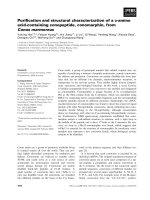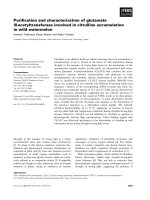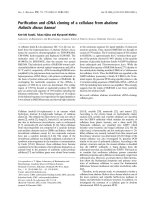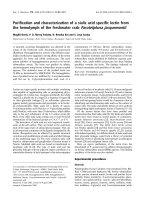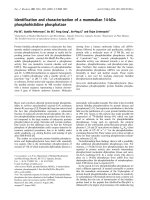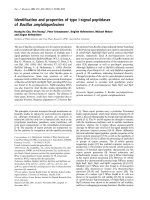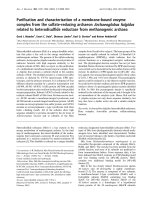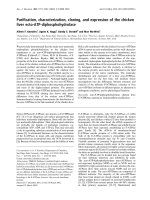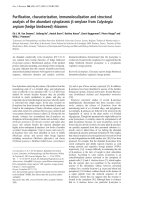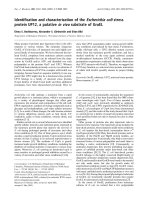Báo cáo Y học: Puri®cation and properties of an alkaline proteinase of Fusarium culmorum doc
Bạn đang xem bản rút gọn của tài liệu. Xem và tải ngay bản đầy đủ của tài liệu tại đây (296.63 KB, 10 trang )
Puri®cation and properties of an alkaline proteinase
of
Fusarium culmorum
Anja I. Pekkarinen
1,2
, Berne L. Jones
3
and Marja-Leena Niku-Paavola
2
1
Department of Agronomy, University of Wisconsin-Madison, USA;
2
VTT Biotechnology, Finland;
3
USDA-ARS, Cereal Crops Research Unit, Madison, WI, USA
The disease Fusarium head blight (scab) causes severe
problems for farmers and for the industries that use cereals.
It is likely that the fu ngi that cause scab (Fusarium spp.) use
various enzymes when they invade grains. We are studying
enzymes that the fungi may use to hydrolyze grain proteins.
To do this, Fusarium culmorum was grown in a gluten-con-
taining medium from which an alkaline serine proteinase
with a molecular mass of 28.7 kDa was puri®ed by size-
exclusion and cation exchange chromatographies. The
enzyme was maximally active at pH 8.3±9.6 and 50 °C, but
was unstable under these conditions. It hydrolyzed the syn-
thetic substrates N-succinyl-Ala-Ala-Pro-Phe p-nitroanilide
and, to a lesser extent, N-succinyl-Ala-Ala-Pro-Leu
p-nitroanilide. It was inhibited by phenylmethanesulfonyl
¯uoride and chymostatin, but not by soybean trypsin or
Bowman±Birk inhibitors. Parts of the amino-acid sequence
were up to 82% homologous with those of several fungal
subtilisins. One of the active site amino acids was d etected
and it occupied the same relative position as in the other
subtilisins. Therefore, on the basis of these characteristics,
the proteinase is subtilisin-like. Puri®cation of the enzyme
was c omplicated by the f act t hat, when puri®ed, it apparently
underwent autolysis. The presence of extraneous protein
stabilized the activity.
Keywords: cereal; fungus; chymotrypsin; subtilisin;
proteinase.
Fusarium head blight (FHB, scab) has for many years been a
serious problem for cereal producers and for the various
cereal industries. The majority of past FHB epidemics
have been caused by the f ungus Fusarium gram inearum
(Gibberella zeae), but some infestations have also been due
to F. culmorum and/or F. avenaceum (G. avenacea), espe-
cially in Europe [1]. FHB causes severe yield losses in w heat
and barley and reduces the crop quality by destroying some
of the necessary grain components and by producing
mycotoxin s. Fusarium contamination of malts is also
associated with ÔgushingÕ problems t hat have sometimes
plagued the brewing i ndustry [2±4].
The role that fungal proteinases play in the FHB
pathogenesis is not known, but there are indications that
these enzymes may contribute to some of the problems that
are associated with diseased wheat. Electron microscope
examinations have indicated that the wheat endosperm
protein matrix disappeared when F. graminearum invaded
the aleurone layer [5] or the s tarchy endosperm tissue [5,6].
F. graminearum infections also caused a d ecrease in the
relative proportions of extractable wheat albumins a nd
glutenins [7]. When either F. graminearum or F. culmorum
was grown on m edia t hat contained c ereal proteins, it
produced proteinases that had predominantly a lkaline pH
optima [8]. An a lkaline proteinase activity that was associ-
ated with the breakdown of storage proteins has also been
detected in FHB-diseased wheat kernels [6].
Cereal grains contain multiple proteins that inhibit the
activities of microbial proteinases [9,10] and it seems likely
that they make some of these inhibitors to slow or prevent
the disruption o f the grain proteins during fungal attacks.
We are purifying, identifying and characterizing the pro-
teinases that are synthesized by Fusarium fungi when they
are grown on grain protein-containing media. These will
then be used to probe for barley inhibitors that inactivate
Fusarium proteinases, to de®ne the interactions between
these enzymes and inhibitors and to ascertain whether or
not they occur w ithin infested grains. In this paper we report
the puri®cation and characterization of one of the protein-
ases that is produced by F. culmorum.
MATERIALS AND METHODS
Fusarium
culture
F. culmorum (strain VTT-D-80148) was grown in Arm-
strong medium that was modi®ed by replacing its inorganic
nitrogen salt with gluten, so that it induced the fungus to
Correspondence to A. I. Pekkarinen, USDA-ARS, CCRU, 501 N.
Walnut St ., Madison, WI 53705±2334, USA. Fax: + 1 608 264 5528,
Tel.: + 1 608 262 4478, E-mail: apekkarinen@facsta.wisc.edu
Abbreviations: CMC, carboxymethyl cellulose; E-64, trans-Epoxy-
succinyl-
L
-leucylamido-(4-guanidino)butane; PMSF, phenyl-
methanesulfonyl ¯uoride; pAPMSF, p-amidino
phenylmethanesulfonyl ¯uoride; CST, chymostatin; STI, soybean
trypsin inhibitor; BBI, Bowman±Birk inhibitor; TLCK, Na-p-tosyl-
L
-lysine chloromethyl ketone; TPCK, N-tosyl-
L
-phenylalanine
chloromethyl ketone; SAAPFpNA, N-succinyl-Ala-Ala-Pro-Phe
p-nitroanilide; SAAP LpNA, N-succinyl-Ala-Ala-Pro-Leu p-nitro-
anilide; BVGRpNA, N-benzoyl-Val-Gly-Arg p-nitroanilide; GPpNA,
N-glutaryl-
L
-Phe p-nitroanilide; BApNA, Na-benzoyl-
L
-Arg p-nitro-
anilide.
Enzymes: chymotrypsin (EC 3.4.21.1); trypsin (EC 3.4.21.4); subtilisin
(EC 3.4.21.62); oryzin (EC 3.4.21.63).
(Received 16 August 2001, revised 20 November 2001, accepted 23
November 2001)
Eur. J. Biochem. 269, 798±807 (2002) Ó FEBS 2002
produce a lkaline proteinases [8]. Two litres of inoculum was
grown in Armstrong mineral medium [11] and it was used to
start a 30-L culture that was identical, but contained 1 gáL
)1
(NH
4
)
2
SO
4
. This, in turn, was used to inoculate a ®nal
270-L growth medium preparation. The 300-L growth
medium was as described previously [8], except that it was
prepared with tap water. It contained 8 gáL
)1
of an impure
gluten preparation (80% protein, 7% fat, Sigma #G5004,
St Louis, MO, USA) that had been dry-heat sterilized (10 h
at 160 °C). Fermentation was in a N ew Brunswick Scienti®c
IF400 fermenter.
Throughout the fermentation, the p H of t he culture
medium was maintained at 4.5±5.0 by adding either NaOH
or H
3
PO
4
as needed, and the temperature was maintained at
18±21 °C. The fungal growth was monitored by measuring
the glucose concentration and chymotrypsin/subtilisin pro-
teinase activities of samples that were removed from the
growth medium 0, 19, 24, 27, 31 and 42 h after the culture
was started. The purity of the culture was con®rmed by agar
plating and by microscopic examination. When 50% of
the glucose had been used up (43 h), the m ycelia were
separated by centrifugation with an Alfa Laval Separator
Type BPTX 205SGD-30CDP (Sweden). This step yielded
270 L of supernatant that was concentrated to 16.6 L with
four PCI modules (PCI, Whitchurch, UK) using ES625
membranes (nominal molecular weight cut-off 10 000 Da,
2.6 m
2
each). The concentrate was divided into appropriate
aliquots, frozen, and stored at )20 °C.
Analytical methods
Nonspeci®c proteinase assay. An azogelatin assay [12] was
used for analyzing the total nonspeci®c proteinase activities.
Each reaction was started by adding 0.5 mL of enzyme
preparation that was diluted (with 30 m
M
sodium citrate,
pH 6.3) to contain 1±2 lgámL
)1
of protein, to 2 mL of
12.5 mgámL
)1
azogelatin in 100 m
M
buffer. Unless indicat-
ed otherwise, the reactions were carried out at 40 °Cin
80 m
M
sodium citrate, pH 6.0, buffer. Samples (0.5 mL
each) were removed from each reaction at appropriate times
(normally 0, 10, 30 and 60 min), mixed with 0.75 mL of
25% trichlo roacetic acid, held in an ice-water b ath for
20 min, and centrifuged at 10 800 g for 10 min, at room
temperature. The absorbance values of the supernatants
were measured at 440 nm. The enzymatic activity, in
arbitrary units (U), was the change in absorbance units
per minute multiplied by 100. Each assay was performed in
duplicate.
Speci®c chymotrypsin/subtilisin-like activity assay.The
speci®c chymotrypsin/subtilisin-like activities were mea-
sured with the substrate N-succinyl-Ala-Ala-Pro-Phe
p-nitroanilide (SAAPFpNA, Sigma, 5 m
M
) dissolved in
175 m
M
Tris/HCl, pH 9 .0. The substrate solution (90 lL)
was heated to 28 °C, 10 lL of appropriately diluted enzyme
was added and the change in absorbance at 405 nm was
monitored for 3 min. The activities were calculated as
described earlier and are expressed as nkatámL
)1
of sample
[8].
Protein assay. For creating the puri®cation table, the
protein concentrations of solutions were measured with the
Bio-Rad Protein Assay kit (Bio-Rad, Hercules, CA, USA)
[13]. Bovine serum albumin (BSA, Pierce, Rockford, IL,
USA) was used to prepare a standard curve. In all other
cases the protein contents of the enzyme solutions were
calculated by measuring their absorbance at 280 nm and
assuming that 1 mgámL
)1
of protein had an absorbance
of 1.0.
Puri®cation of the enzyme
All puri®cation steps were carried out at room temperature
and the chromatography fractions were always collected in
glass tubes that had been silanized with trimethylchloro-
silane (Sigma #T-4252). For silanization, the tubes were
placed in a dessicator with 5 mL of the reagent and the
dessicator was evacuated and held at room temperature for
16 h, after which the derivatized tubes were rinsed thor-
oughly with MilliQ-water.
The concentrated culture medium was centrifuged at
1700 g for 5 min a nd 26.5 mL o f t he supernatant was
appliedtoa2.5´ 70 cm Bio-Gel P30 (Bio-Rad) size
exclusion column that was equilibrated with 20 m
M
NH
4
acetate, pH 5.0. The column was elut ed with the same
buffer and 200-drop fractions were collected. The absor-
bance values of t hese and of the chromatography fractions
in subsequent steps were measured at 280 nm and their
nonspeci®c proteinase and c hymotrypsin/subtilisin-like
activities were both a nalyzed at pH 9.0.
The fractions that voided the P-30 column were com-
bined and subjected to carboxymethyl cellulose (CM52,
Whatman) cation exchange chromatography at pH 5.0 on a
1 ´ 6 cm column. Elution was with a 20-m
M
to 300 m
M
NH
4
acetate, pH 5.0, linear gradient (45 mL of each
concentration) and 2.8-mL fractions were collected. The
fractions having the highest proteolytic activities (19±23)
were pooled and the pool was divided into 2-mL aliquots
that were stored at )20 °C. The enzyme was stored in this
partially puri®ed state because it was not stable when
completely puri®ed. Immediately prior to using the enzyme
for studies, it was subjected to a ®nal HPLC-cation
exchange puri®cation step with a Shodex IEC CM-825,
8 ´ 75 mm column (Phenomenex, Torrance, CA, USA).
Each thawed aliquot was ®ltered through an AcrodiscÒ
4CR PTFE 0.45 lm ®lter (Gelman Sciences, Ann Arbor,
MI, USA), diluted ®vefold with MilliQ-water, and ap plied
to the column, which had been equilibrated with 50 m
M
NH
4
HCO
3
, pH 8, buffer. The loaded column was washed
at 1 mLámin
)1
with 6 mL of t he pH 8 buffer a nd the
proteins were separated w ith a 12.5-mL linear gradient
that ran f rom 50 m
M
to 175 m
M
NH
4
HCO
3
.The
280 nm-absorbing fractions were collected and immediately
adjusted to pH 4±5 with approximately 40 lL of 2 0% ac etic
acid. The activities of the fractions were measured at pH 9.0
and the material that showed chymotrypsin/subtilisin spe-
ci®c activity was called the Ôpu ri®edÕ enzyme or ÔCM-HPLCÕ
fraction.
To ascertain its purity, an aliquot of the CM-HPLC
preparation was boiled for 1.5 min with SDS sample buffer
and separated on a 12% SDS/PAGE gel [14]. The gel was
incubated for 45 min, with shaking, in 50% methanol/12%
acetic acid. It was stained in 0.1% Coomassie Brilliant Blue
R-250 dissolved in 40% methanol/1% acetic acid and
destained with the same solvent. A Precision Protein
Standard (Bio-Rad) sample was used to calibrate the gel.
Ó FEBS 2002 An alkaline Fusarium proteinase (Eur. J. Biochem. 269) 799
Characterization of the proteinase
Eects of pH and temperature on activity. The activities
of the partially puri®ed enzyme, obtained by CMC
separation at pH 5.0, were measured by using the azogelatin
assay at 40 °C and pH 3.6, 4.1, 4.5, 5.0 and 5.5 (Na acetate),
pH6.0,6.5and6.9(Nacitrate),pH6.9,7.5,7.9,8.3,8.7
and 9.1 (Tris/HCl) and pH 9.2, 9.6, 10.0 and 10.4 (Caps).
All buffers were 80 m
M
. The activitie s of the CM-HPLC
puri®ed proteinase were analyzed at pH 4.6, 6.0, 8.7 and 9.4
inthesamebuffers.
The effect of temperature on the proteinase activity was
studied at 45, 50 and 56 °CatpH6.0(80m
M
Na citrate)
and at 40, 45 and 50 °CatpH8.7(80m
M
Tris/HCl).
Eects of pH and temperature on the enzyme stability.
For measuring the stability of the proteinase at different pH
values, the puri®ed enzyme was incubated for 90 min at
40 °Cin30m
M
buffers: Na acetate, pH 4.1 and 4.9; Na
citrate, pH 5.9 and 6.4; or Tris/HCl, pH 7.7 and 8.5. The
activity of each sample was m easured after 0 and 90 min of
incubation. For measuring its thermal stability, the puri®ed
proteinase was incubated in 30 m
M
Na citrate, pH 6.3, for
50 min, at 24, 40, 50 or 60 °C. Its activity was measured
after 0 and 50 min of incubation. The activity retention at
each pH or temperature was expressed a s the proportion of
the initial activity that remained after the incubation.
Eects of class speci®c inhibitors on the enzyme. The
mechanistic class of the proteinase was determined by
measuring its activity at pH 6.0 in the presence of nine class-
speci®c p rotease i nhibitors. Samples of the semipuri®ed
(subjected to CMC open-column chromatography) prepa-
ration were incubated on ice for 30 min with 50 l
M
trans-
epoxysuccinyl-
L
-leucylamido-(4-guanidino)butane (E-64),
25 m
M
EDTA, 5 m
M
1,10-phenanthroline in 20% dimethyl-
sulfoxide, 50 l
M
pepstatin A in 20% m eth anol, 0 .5 or
5.0 m
M
phenylmethanesulfonyl ¯uoride (PMSF) in 20%
isopropanol, 8.2 or 82 l
M
chymostatin (CST) in 20%
dimethylsulfoxide, or 5.0 l
M
soybean trypsin inhibitor (STI,
Type II-S, Sigma #T-9128). S amples of the puri®ed enzyme
(about 2 lgámL
)1
) were incubated as above in the presence
of 165 l
M
CST, 5.0 m
M
PMSF, or 5.0 m
M
4-amid-
inophenylmethanesulfonyl ¯uoride (pAPMSF), each of
which was dissolve d in 20% dimethylsulfoxide, o r in a
12.5-l
M
solution of soybean Bowman±Birk inh ibitor (BBI),
or 5.0 l
M
STI. Control reactions were carried out with
enzyme that was preincubated in water or in 20%
dimethylsulfoxide, methanol or isopropanol, as appropri-
ate. In the ®nal reaction mixtures these enzyme-inhibitor
mixtures were all diluted ®vefold with substrate solution.
The effects of selected serine class proteinase inhibitors on
the hydrolysis of azogelatin at pH 6.0 by several commer-
cially available serine proteinases were examined. One set of
assays was carried out with 48 lgámL
)1
(2.0 l
M
) bovine
a-chymotrypsin (TLCK treated, Type VII, #C-3142, EC
3.4.21.1) or 1.0 lgámL
)1
(0.04 l
M
) bovine trypsin (TPCK
treated, Type XIII, #T-8642, EC 3.4.21.4) in the presence of
1.0 m
M
PMSF, 1.0 m
M
pAPMSF, 33 l
M
CST, 1.0 l
M
STI
or 2.5 l
M
BBI. In the other set, t he effects of 1.7 l
M
CST or
2.5 l
M
BBI on 0.8 lgámL
)1
subtilisin Carlsberg (Type VIII
bacterial, Bacillus licheniformis, #P-5380, EC 3.4.21.62)
or 1.4 lgámL
)1
oryzin (Aspergillus oryzae protease, Type
XXIII, #P-4032, EC 3.4.21.63) were studied. The PMSF,
pAPMSF and CST were dissolved in 4% dimethylsulfoxide.
Appropriate controls were conducted. All of the inhibitors
and commercial enzymes were pu rchased from Sigma.
To ascertain the effects of CST and STI on the
SAAPFpNA hydrolysis activity, samples of the puri®ed
Fusarium proteinase were incubated in polypropylene tubes
with 16.5 l
M
CST in 20% dimethylsulfoxide or 10 l
M
STI,
on ice, for 50 min and their activities were measured as
described above under Ôspeci®c chymotrypsin/subtilisin-like
activity assayÕ except that the substrate buffer contained 4 %
dimethylsulfoxide. For control reactions, the enzyme was
preincubated with water or 20% dimethylsulfoxide. The
®nal concentrations of STI or CST in the reaction mixtures
were 1.0 or 1.7 l
M
, respectively.
Eects of calcium on the activity and stability of the
proteinase. The effect of Ca acetate on the proteolytic
activity was analyzed in both 80 m
M
Na citrate, pH 6.0
(0, 5 or 20 m
M
Ca
2+
)and80m
M
NH
4
acetate, pH 5.4
(0,1,5or20m
M
Ca
2+
) buffers. To determine the effect
of calcium on the enzyme stability, the puri®ed enzyme
was incubated for 95 min at 40 °Cin30m
M
Na acetate,
pH 4.9, that contained 0 or 100 m
M
Ca acetate. The
activities of the samples were measured after 0 and 95 min
of incubation. To ensure that the differing calcium levels
did not affect the activity measurements, the Ca acetate
concentrations of all of the reactio n mixtures were
adjusted to 20 m
M
.
Eect of added protein on the proteinase stability.
A solution o f puri®ed enzyme was i ncubated at 40 °C
for 90 min with 0, 1.0, 2.5, 5.0 or 10 lgámL
)1
of BSA in
30 m
M
Na citrate, pH 6.3. The activity of the sample
without BSA was measured as a control and the activities
of all of the samples were analyzed after 90 min of
incubation. The concentration of BSA in each of the
activity analysis reaction mixtures was a djusted t o
4 lgámL
)1
to ensure that the varying BSA levels did not
affect the results.
Substrate speci®city and kinetic constants for SAAPFpNA.
To de®ne the substrate speci®city of the enzyme, its activity
was measured in duplicate with the substrates SAAPFpNA,
N-succinyl-Ala-Ala-Pro-Leu pNA (SAAPLpNA), N-gluta-
ryl-
L
-Phe pNA (GPpNA), N-benzoyl-Val-Gly-Arg pNA
(BVGRpNA), or Na-benzoyl-
L
-Arg pNA (BApNA). The
concentrations of all substrates were 5 m
M
. The method was
as described above under Ôspeci®c chymotrypsin/subtilisin-
like activity assayÕ, except that all of the reactions contained
4% dimethylsulfoxide, in which the substrates were dis-
solved. The reactions contained 0.06 (SAAPFpNA), 0.22
(SAAPLpNA and BVGRpNA) or 1.1 (BApNA and
GPpNA) lgofprotein.
The K
m
value of the proteinase for SAAPFpNA was
determined by measuring the activity of the enzyme
(0.03 lg protein per reaction) with 0.13±8.0 m
M
concen-
trations of the substrate in pH 9.0, 175 m
M
Tris/HCl
solutions in the presence or absence of 4% dimethylsulf-
oxide and at pH 6.0 in 4% dimethylsulfoxide, 175 m
M
Na
citrate. The analyses were carried out in duplicate and the
kinetic constants were calculated from Lineweaver±Burk
plots.
800 A. I. Pekkarinen et al. (Eur. J. Biochem. 269) Ó FEBS 2002
Eect of azogelatin concentration on the proteolytic
activity. The effect of azogelatin on the proteolytic activities
was measured with substrate concentrations between 0.5
and 10 mgámL
)1
in solutions containing either 80 m
M
Na
citrate, pH 6.0, or 80 m
M
Tris/HCl, pH 8.7. The enzyme
concentrations of the pH 6.0 and 8.7 reaction mixtures were
0.44 and 0.22 lgámL
)1
, respectively.
Molecular mass analysis. The molecular mass of the
proteinase was determined by MALDI-TOF analysis, using
a Bruker Bi¯ex III mass spectrometer, at the University of
Wisconsin Biotechnology Center, WI, USA.
Determination of portions of the amino-acid sequence.
CM-HPLC puri®ed enzyme was freeze-dried and submitted
to the Protein Chemistry Laboratory of the University of
Texas Medical Branch Cancer Center, Galveston, USA, for
amino-acid sequence analysis. The enzyme was digested
with trypsin, the resulting peptides were separated by reverse
phase-HPLC and selected peptides were subjected to amino-
acid sequence analysis using the Edman degradation
method.
RESULTS AND DISCUSSION
Puri®cation
Depending on which analysis method was used for
measuring the activities, the ®nal yield of the proteinase
was 5.5 or 11% (Table 1). The speci®c activities increased
about fourfold (SAAPFpNA) or eightfold (azogelatin) as
the puri®cation process progressed from culture medium
concentrate to CM-HPLC preparation. The open column
CMC separation gave the largest single puri®cation, but
after this step two distinct proteinases were still present. To
separate these two enzymes, it was necessary to carry out a
®nal CM-HPLC separation at pH 8 (Fig. 1). No separation
was obtained when the HPLC separation was carried out at
pH values lower than 8. A typical separation is shown in
Fig. 1, where the enzyme of interest is indicated with an
arrow. Preliminary studies established that the other major
eluting peak contained a trypsin-like proteinase. This
trypsin-like enzyme is being studied and will be reported
elsewhere.
SDS/PAGE analysis of the puri®ed enzyme showed that
the predominant p rotein had a molecular mass of
26.8 kDa a nd that a small amount of slightly faster
migrating proteins were present (Fig. 2). Mass spectrometry
indicated that fresh enzyme preparations contained a
protein of mass 28 663 50 Da. Some puri®ed samples
also included small amounts of proteins of 4600, 11 180,
17 070 and 17 860 Da. Apparently, contaminants were
sometimes present and/or the enzyme underwent partial
autolysis. When the puri®ed enzyme was subjected to a
Table 1. Puri®cation of the F. culmorum proteinase.
Puri®cation
step
Protein
a
(mg)
Activity Speci®c activity
(U
b
)(lkat
c
)(Uámg
)1
)(lkatámg
)1
) Yield (%) Puri®cation (fold)
Crude 4.7 1400 4.7 300 1.0 100
b
100
c
1.0
b
1.0
c
P30 pool 1.9 1300 1.8 680 0.95 93
b
38
c
2.3
b
1.0
c
CMC pool 0.33 660 1.1 2000 3.3 47
b
23
c
6.7
b
3.3
c
CM-HPLC 0.06 150 0.26 2500 4.3 11
b
5.5
c
8.3
b
4.3
c
a
Based on 26.5 mL of growth medium concentrate.
b
Activities were measured with the azogelatin assay: U DA
440
´ 100 min
)1
.
c
Activities were measured with N-succinyl-Ala-Ala-Pro-Phe p-nitroanilide.
Fig. 1. A typical cation exchange HPLC chromatogram of a F. cul-
morum proteinase: absorbance at 280 nm (Ð). Thegradient( )was
run from 50 m
M
to 175 m
M
NH
4
HCO
3
, pH 8. The proteinase that is
described in this report is indicated with an arrow.
Fig. 2. SDS/PAGE pattern of the puri®ed proteinase. Lanes 1 and 2:
0.5 and 1.5 lg of CM-HPLC puri®ed enzyme; lane 3: molecular mass
standards.
Ó FEBS 2002 An alkaline Fusarium proteinase (Eur. J. Biochem. 269) 801
second pH 8 HPLC separation, almost all of the proteinase
was lost and what remained eluted as a broad peak. This
repeated HPLC separation did remove some 17.9 k Da
protein whose N-terminal amino-acid sequence was highly
homologous with that of a portion of a trypsin-like
proteinase from Fusarium ox ysporum (results not shown).
Properties of the proteinase; pH optimum and effect
of temperature on activity
The proteinase hydrolyzed azogelatin between pH 4.0 and
10.5 and was optimally active at pH 8.3±9.6 (Fig. 3). This
result was based on data obtained by analyzing the activities
of a mixture of the two Fusarium proteinases. However,
when the activities of the puri®ed enzyme were measured at
pH 4.6, 6.0, 8.7 and 9.4, essentially identical results were
obtained (Fig. 3). The enzyme thus functions at pH 6, the
physiological pH of grain, but not at its maximal rate. The
broad pH optimum of this proteinase resembles those of
the alkaline proteinases from some Aspergillus species
[15±18], but those of Fusarium sp. ÔS-19-5Õ [19] and
F. graminearum [20] have somewhat sharper pH optima,
at approximately p H 10. A t rypsin-like proteinase from
F. oxysporum had a pH optimum of 8±11 [21].
At pH 8.7 (Fig. 4) the i nitial activity of t he enzyme
increasedwithtemperature,upto50°C. However, the
enzyme was unstable above 40 °C, so the reaction rate at
50 °C decreased with time. Thus, for the purposes of this
assay method, 40 °C was the most appropriate temperature
for carrying out the analyses. The proteinase was more
temperature stable when assayed at pH 6.0, but even at this
pH the activity was slightly un stable at 45 °C and it dropped
off quickly at 56 °C. Several alkaline proteinases from
Aspergillus and Fusarium species have temperature optima
of 40 °C [15,16,18,20,22]. The alkaline proteinase of
Fusarium sp. ÔS-19-5Õ was maximally active at 50 °Cand
pH 10.5 when its activities were determined with a 20-min
assay [19].
Calcium had a negligible effect on the activity of the
F. culmorum proteinase in the presence of either Na citrate
or NH
4
acetate buffer. The NH
4
acetate analyses w ere
carried out to ensure that the calcium concentration of the
reaction was not affected by the presence of citrate ion,
which is a chelating agent. The enzyme therefore behaved
like the alkaline proteinase of Fusarium sp. ÔS-19-5Õ,which
also was not affec ted by calcium [19].
Factors affecting the stability of the proteinase
The proteinase was heat labile and subject to inactivation
at alkaline pH. When the puri®ed proteinase was incu-
bated at various temperatures at pH 6.0, the remaining
activities were 88, 55, 29 and 0% after 50 min at 24, 40,
50 and 60 °C, respectively. About a third of the enzyme
remained active for 90 min at various pH values from 4.1
to 7.7 at 40 °C, but all of the activity was lost at pH 8.5.
Calcium did not stabilize the enzyme at pH 4.9. After
95 min of incubation in the presence and absence of
Ca
2+
, the remaining activities were 37 and 32%, respec-
tively. Tomoda et al. [19] showed previously that calcium
stabilized the alkaline proteinase of Fusarium sp. ÔS-19-5Õ
at pH 8±9, but not at pH 5 a nd 40 °C. However, the
ÔS-19-5Õ enzyme was not as sensitive to inactivation at pH
9 or at elevated temperatures as this F. culmorum
proteinase. Bovine chymotrypsin and trypsin are stabilized
by calcium [23,24].
The addition o f 2.5 lgámL
)1
of BSA per 1 lgámL
)1
of
proteinase was suf®cient to completely maintain the
proteinase activity for at least 90 min at pH 6.0 and 40 °C
(Table 2), conditions under which the unp rotected enzyme
was almost completely inactivated. BSA, and presumably
other proteins, apparently protects the proteinase from
autolysis, inhibits conformational changes or prevents it
from binding to its containers. Hence, some of the s tability
features of the enzyme may be affected by small amounts of
contaminating proteins.
Fig. 3. The eect of pH on the proteinase activity, measured with the
azogelatin method. The enzyme preparations analyzed were: open
symbols, a CMC pool or; close d symbols, e nzyme puri®ed by
CM-HPLC. All buers were 80 m
M
and contained: Na acetate (s,d),
Na citrate (h,j), Tris/H Cl (n,m)orCaps(e,r).
Fig. 4. The eects of temperature on the proteinase activities. The
analysis temperat ure s were: 40 °C(s), 45 °C(h,j), 50 °C(n,m), or
56 °C(r). The a ssays were run at pH 8.7 (open symbols) or pH 6.0
(closed symbols).
802 A. I. Pekkarinen et al. (Eur. J. Biochem. 269) Ó FEBS 2002
The enzyme is a serine class proteinase
Class speci®c proteinase inhibitors other than those that
inactivate serine proteinases had no signi®cant effect on the
activities of the CMC preparation ( Table 3). The small
effect of soybean trypsin inhibitor (STI) was probably due
to some contaminating proteinase that was in the CMC
preparation, because the puri®ed proteinase was not
inhibited either by it or by a Bowman±Birk type trypsin-
chymotrypsin inhibitor (BBI). The very strong inhibitions
caused by PMSF and chymostatin (CST) indicated that the
enzyme was a serine proteinase and belonged to eithe r the
chymotrypsin or subtilisin family. Under the analysis
conditions that were used in this experiment, a TLCK-
treated bovine a-chymotrypsin was inhibited 64% by BBI
and 98% by CST. Neither oryzin nor subtilisin were
affected by BBI, but they were almost totally inhibited by
CST. In this aspect, the F. culmorum proteinase resembles
subtilisins. Howe ver, the a-chymotrypsin was unexpectedly
inhibited by 40% in the presence of STI, showing that
classi®cation by Ôspeci®cÕ inhibitors is not straightforward
and may depend on the analysis method.
The activity of the puri®ed F. culmorum proteinase was
25% higher in the presence of STI or BBI than in the
control (Table 3). This is probably not due to an activation
of the proteinase but rather to the general stabilization of
the enzyme by proteins, which was mentioned earlier. Both
STI and BBI are proteins. It is also possible that the small
amount of contaminating trypsin-like p roteinase caused an
inactivation of the ÔsubtilisinÕ proteinase and, when that
contaminant was inhibited by STI or BBI, the proteinase
remained active. STI and CST both caused similar effects
when the enzymatic activities were measured with the
synthetic peptide substrate (Table 3).
Amino-acid sequence studies
Several attempts were made to sequence the N-terminal
amino acids of the enzyme, but no data were obtained,
indicating that the N-terminus was probably blocked. The
enzyme was therefore digested with trypsin, and the
resulting peptides were separated by HPLC and some were
sequenced. Four of the peptides obtained had sequences
of: (1) GSTSYIYDTSAG SGTYAYIVDTGIITSHN; (2)
GFNWAANDIISK; (3) SYSNYGTVL and; (4) DIFAPG
TSVLSS. These peptides were homologous with sections
of other f ungal proteinases ( Table 4). Peptides 3 a nd 4
occupied adjacent areas of th e sequences of several of these
proteinases. However, the peptide bond that was cleaved to
separate these two peptides connected the amino acids
leucine and aspartic acid. Such bonds are not normally
cleaved by trypsin, but are by subtilisin. This indicates that
these peptides were probably separated by an autolytic e vent
rather than by trypsin hydrolysis. In the subsequent
discussion the peptides 3 and 4 are considered as a single
peptide.
Table 4 lists the corresponding amino-acid sequences of
several homologous fungal proteinases. The protein that
showed the highest homology with all three of the F. c ul-
morum peptides was the subtilisin-like proteinase from
Cephalosporium acremonium, whose corresponding sequen-
ces were 82% identical to those of F. culmorum.The
proteinases from several Aspergillus species, from Tricho-
derma harzianum, Metarhizium anisopliae, Magnaporthe
poae, Tritirachium album, Yarrowia lipolytica and the
Fusarium sp. ÔS-19-5Õ and oxysporum contained sequences
that were 44±76% identical. Subtilisin-like proteinases from
M. poae [25] and F. oxysporum [26] have been detected in
infected host plants, although, their roles have not been
established.
The proteinases that have been cloned f rom Fusarium sp.
ÔS-19-5Õ and F. oxysporum showed less homology to the
peptides from the F. culmorum proteinase tha n those of
several other fungal species (Table 4). This was somewhat
surprising, considering that most of the peptide sequences
from the Aspergillus species were highly conserved. Also, the
proteinases K and R from T. album were 85% identical to
each other, showing that similar e nzymes from a single
species are often highly homologous. However, such
sequences may vary remarkably, as shown by the peptides
from A. niger and M. anisopliae.
The amino acids that comprise the catalytic triad of the
serine proteinases (His, Asp and Ser) occur in d ifferent
Table 2. Stabilization of the Fusarium proteinase by BSA. The samples
were incubated at 40 °Cfor90minatpH6.0.
BSA (lgámL
)1
) Remaining activity (%)
08
1.0 63
2.5 106
5.0 109
10.0 100
Table 3. Inhibition of the Fusarium proteinase activity by various class
speci®c inhibitors.
Inhibitor
Concentration
(l
M
)
Inhibition
(%)
a
Inhibition
(%)
b
E-64 10 2 ±
EDTA 5000 8 ±
1,10-Phenathroline 1000 8 ±
Pepstatin A 10 16 ±
pAPMSF 1000 ± 85
PMSF
100 71 ±
1000 90 100
Chymostatin
1.7 74 100
c
17 74 ±
33 ± 100
Soybean
trypsin inhibitor
1.0 35 )22
1.0 ± )38
c
Bowman±Birk
inhibitor
2.5 ± )25
a
Measured with a mixture of two proteinases.
b
Measured with the
puri®ed proteinase.
c
Measured with the substrate SAAPFpNA at
pH 9.0. All of the other measurements were made with azogelatin
at pH 6.0.
Ó FEBS 2002 An alkaline Fusarium proteinase (Eur. J. Biochem. 269) 803
Table 4. Partial amino-acid sequences of fungal alkaline proteinases that show homology with the F. culmorum enzy me. Identical residues are indic ated with dashes and missing peptides with dots. The bold
aspartic acid (D) indicates the position of the active site Asp r esidue that is conserved i n all of these f ungal subtilisins. The percentage of identical amino acids in all three peptides is listed, followed (in parentheses)
by the percentages i n the individu al peptid es.
Fungus Gene Sequences % Identity Database entry Reference
F. culmorum
???GSTSYIYDTSA.GSGTYAYIVDTGIITSHN??? ???GFNWAANDIISK??? ???SYSNYGTVLDIFAPGTSVLSS???
Cephalosporium
acremonium
ALP 140 D V LE 168 231 V NR242 312-F S I A332 82 (86, 75, 81) SWISS-PROT #P29118 [29]
Aspergillus niger PEPD
142S D D E V LAT 170 233 V 244 314-F S-V EQ A334 76 (72, 92, 71) TrEMBL #Q00206 [30]
A. niger PEPC
161NFNK-L-ASEG E-VD TI NVD-V189 254-VEY-VQAH-K-265 344YF ECT LNI T364 44 (38, 33, 57) SWISS-PROT #P33295 [31]
A. nidulans PRTA
141A T-V E V NAD-E169 232 V 243 313-F S-V QDI A333 73 (69, 92, 67) TrEMBL #Q00208 [32]
A. fumigatus ALP
142A D A V S NVN-V170 233 V V 244 314-F S-V QDI A334 71 (69, 83, 67) SWISS-PROT # P28296 [33]
A. ¯avus ALP
142P D NG E V I NVD-E170 233 V 244 314YF S-V QNI A334 68 (62, 92, 62) SWISS-PROT # P35211 [34]
A. ¯avus None
142Q D E V S-VNVD-E170 233 V 244 314-F F-K-V-V QDI A334 68 (66, 92, 57) TrEMBL #Q9UVU3 [35]
A. oryzae ALP
142Q D E V S-VNVD-E170 233 V 244 314-F F-K-V-V QDI A334 68 (66, 92, 57) SWISS-PROT # P12547 [36]
Trichoderma
harzianum
PRB1
141 S A F V S N Q169 232-Y V V 243 318-FT AGV-V VNI 338 69 (76, 75, 57) SWISS-PROT #Q03420 [37]
Metarhizium
anisopliae
PR1B
124 D E CS I DAT-P152 210SNVI M-FVA-221 296 P-V V-I T316 65 (69, 33, 76) TrEMBL #O14410 [38]
M. anisopliae PR1D
136NA-G A Q FG-VM RAT-R164 227 D V V 238 314QG P DGIE-A334 61 (55, 75, 62) TrEMBL #Q9P806 [39]
Magnaporthe poae mp1
133N D-V PAGL-ADH I LD-E-V162 230 S VK TA-241 311WF P-V-V VA-E-A331 56 (50, 58, 57) TrEMBL #Q9Y778 [25]
Tritirachium album PROR
127-TST-R D Q CV-VI VEA P155 218-MDFV YRNR229 299-F S DI T319 56 (52, 33, 76) SWISS-PROT # P23653 [40]
T. album PROK
124-TST-Y E Q-SCV-VI EA P152 215-MDFV-S-KNNR226 296-F S G I T316 55 (52, 25, 76) SWISS-PROT # P06873 [41]
Fusarium sp. ÔS-19-5Õ ALP
120 A-A T Q-AC VI VEDT-P148 211-MDFV-S-YR-R222 292-F RA DIT-T312 55 (55, 33, 67) TrEMBL #Q02291 [42]
F. oxysporum None
131 T N E C VI QLQDF158 215SAVI-GM-FV-G226 302E F-S-V-VL DI T322 52 (59, 25, 57) TrEMBL #O74236 [43]
Yarrowia lipolytica XPR2
180-NYA-VRE-VG.KHP-VS-V S R-T-S208 271 T L Y 282 362QG CV-V SDII-S382 50 (38, 75, 52) SWISS-PROT # P09230 [44]
804 A. I. Pekkarinen et al. (Eur. J. Biochem. 269) Ó FEBS 2002
orders in the primary structures of the subtilisin (Asp-His-
Ser) and chymotrypsin (His-Asp-Ser) families [27]. Peptide 1
from the F. culmorum proteinase contained the catalytic
Asp residue in a position that corresponded to that of the
other subtilisin-like enzymes (Table 4). This is another
strong indication that the enzyme under study is a subtilisin-
like, not a chymotrypsin-like, proteinase. These results
therefore su pport t he observations made with the class
speci®c inhibitors. However, the classi®cation of this
enzyme still needs to be con®rmed by cloning its gene and
determining its entire amino-acid sequence.
The hydrolytic speci®city of the enzyme
When the hydrolytic activities of the proteinase were
measured at pH 9.0 with various synthetic substrates, the
results listed in Table 5 were obtained. The enzyme
hydrolyzed SAAPFpNA faster than the o ther two chy-
motrypsin substrates, SAAPLpNA and GPpNA, indicating
that it has a preference for phenylalanine over leucine and
hydrolyzes small substrates poorly. The K
m
values for
SAAPFpNA were 1.1±3.1 m
M
, depending on the compo-
sition of the substrate buffer (Table 6). The K
m
values
were scarcely affected by pH or the presence of dimethyl-
sulfoxide, but the maximal velocity (V
max
)wastwiceas
great at pH 9 as at 6. The alkaline proteinase from
Aspergillus fumigatus also showed this preference for the
phenylalanine substrate over the leucine one, did not
hydrolyze short substrates (succinyl-
L
-Phe pNA or acetyl-
DL
-Phe pNA) and, in addition, had a similar K
m
value
(0.62 m
M
) for SAAPFpNA [18]. The hydrolysis of
N-benzoyl-Val-Gly-Arg pNA (BVGRpNA), a putative
trypsin substrate, may have been caused by a 17.9-kDa
trypsin-like proteinase contaminant. When the activity of
a subtilisin preparation was measured using this substrate
in the presence of either STI or CST, only the STI
inhibited.
Effect of the azogelatin concentration
on the enzyme activity
As azogelatin is not a homogenous preparation containing
only one protein form, but rather a mixture of proteins of
varying sizes, a true K
m
value cannot be calculated.
However, a Ôpseudo K
m
Õ, was computed for this substrate
at pH 6.0 by nonlinear regression analysis using the
Michaelis±Menten equation (Fig. 5). The ÔK
m
Õ was
1.6 0.3 mgámL
)1
and the maximal activity (V
max
)was
0.93 0.05 U (DA
440
´ 100 min
)1
)per0.22lgproteinat
pH 6.0. The observed maximal activity was 20% lower
than the calculated V
max
. The activities measured at pH 8.7
could not be analyzed using Michaelis±Menten kinetics,
because substrate inhibition occurred at concentrations
>3 mgámL
)1
(Fig. 5).
General remarks
The stability of the proteinase depended on several condi-
tions. Either it adhered to the surfaces of containers or was
inactivated by structural changes [28], because its activity
was recovered much better from silanized glass tubes than
from nonsilanized glass or plastic ones. The puri®ed
proteinase could no longer be detected after it had been
frozen at )20 °C or freeze-dried. In contrast, up to 80% of
the SAAPFpNA hydrolyzing activity was recovered when
the puri®ed enzyme preparation was stored on ice f or
2 weeks. However, dilute (less than 10 lgámL
)1
)enzyme
preparations were u nstable even when stored at 0 °C.
CONCLUSIONS
A proteinase, whose production by F. culmorum was
induced/enhanced in the presence of grain protein, has been
puri®ed from growth medium and characterized. The
properties and the amino-acid sequence of the e nzyme
indicated that it was related to several fungal subtilisins. The
role this enzyme plays in F HB pathogenesis remains to be
determined.
Fig. 5. The eects of a zogelatin concentration on the proteinase activi-
ties at pH 6.0 (s) and 8.7 (d). Thedashedlineshowsthenonlinear
regression analysis curve for the pH 6.0 data.
Table 6. K
m
values and maximal velocities (V
max
)oftheFusarium
proteinase for N-succinyl-Ala-Ala-Pro-Phe pNA at pH 6 .0 and 9.0, with
or without dimethylsulfoxide.
pH;
dimethylsulfoxide (%) K
m
(m
M
)
V
max
(nkatámg protein
)1
)
6.0; 4 3.1 1130
9.0; 0 1.1 1970
9.0; 4 2.3 2270
Table 5. Hydrolytic activities of the Fusarium proteinase measured at
pH9.0with5m
M
synthetic substrates. Values are shown as mean
SD.
Substrate
Activity
(nkatámg protein
)1
)
N-Succinyl-Ala-Ala-Pro-Phe pNA 1360 40
N-Succinyl-Ala-Ala-Pro-Leu pNA 345 32
N-Glutaryl-
L
-Phe pNA 0.2 0.0
N-Benzoyl-Val-Gly-Arg pNA 145 5
Na-Benzoyl-
L
-Arg pNA 2.1 1.2
Ó FEBS 2002 An alkaline Fusarium proteinase (Eur. J. Biochem. 269) 805
ACKNOWLEDGEMENTS
We thank the Kemira Foundation for funding the proteinase
production and Michael Bailey at VTT Biotechnology for culturing
the F. culmorum. The ®nancial support of the Tor-Magnus Enari F und,
the Raisio Group Research Foundation, the American Malting Barley
Association and the Finnish Concordia Association are also greatly
appreciated.
REFERENCES
1. Parry, D.W., Jenkinson, P. & McLeod, L. (1995) Fusarium ear
blight (scab) in small grain cereals ± a review. Plant Path. 44,
207±238.
2. Sloey, W. & Prentice, N. (1962) Eects of Fusarium isolates
applied during malting on properties of malt. ASBC Proc.
24±29.
3. Gjertsen, P., Trolle, B. & Andersen, K. (1965) Studies on gushing
II. Gushing caused by microorganisms, specially Fusarium specie s.
EBC. Proc. 428±438.
4. Schwarz, P.B., Beattie, S. & Casper, H.H. (1996) Relationship
between Fusarium infestation o f barley and the gushing potential
of malt. J. Inst Brew. 102, 93±96.
5. Bechtel, D.B., Kaleikau, L.A., Gaines, R.L. & Seitz, L.M. (1985)
The eects o f Fusarium gramin ear um infection on wheat kernels.
Cereal Chem. 62, 191±197.
6. Nightingale, M.J., Marchylo, B.A., Clear, R.M., Dexter, J.E. &
Preston, K.R. (1999) Fusarium head blight: eect of fun gal pro-
teases on wheat storage proteins. Cereal Chem. 76, 150±158.
7. Boyacioglu, D. & Hettiarachchy, N.S. (1995) Changes in some
biochemical compone nts of wheat grain that was infected with
Fusarium graminearum. J. Cer. Sci. 21, 57±62.
8. Pekkarinen, A., Mannonen, L., Jones, B.L. & Niku-Paavola,
M L. (2000) Production of proteases by Fusarium species grown
on barley grains and in media containing cereal proteins. J. Cer.
Sci. 31, 253±261.
9. Boisen, S. (1983) Protease inhibitors in cereals. Acta Agric. Scan.
33, 369±381.
10. Ryan, C.A. (1990) Protease inhibitors in plants: genes for
improving defenses against insects and pathogens. Ann. Rev.
Phytopath. 28, 425±449.
11. Booth, C. (1977) Fusarium La boratory G uide to the I denti®cation of
the Major Species, Commonwealth Agricultural Bureaux, Kew,
Surrey, UK.
12. Jones, B.L., Fontanini, D., Jarvinen, M. & Pekkarinen, A. (1998)
Simpli®ed endoproteinase assays using gelatin or azogelatin. Anal.
Biochem. 263, 214±220.
13. Bradford, M. (1976) A rapid and sensitive method for the quanti-
tation of microgram quantities of protein utilizing the principle of
protein-dye binding. Anal. Biochem. 72, 248±254.
14. Laemmli, U.K. (1970) Cleavage of structural proteins d uring the
assembly of the head of bacteriop hage T4. Nature 227, 680±685.
15. Ohara, T. & Nasuno, S. (1972) Enzymatic properties of alkaline
proteinase from Aspergillus candidus. Agr. Biol. Chem. 36, 1797±
1802.
16. Kundu, A.K. & Manna, S. (1975) Puri®cation and characteriza-
tion of extracellular proteinases of Aspergillus oryzae. Appl.
Microbiol. 30, 507±513.
17. Impoolsup, A., Bhumiratana, A. & Flegel, T.W. (1981) Isolation
of alkaline and neutral proteases from Aspergillus ¯avus var.
columnaris, a soy sauce koji mold. Appl. Env. Microbiol. 42,
619±628.
18. Larcher, G ., Bouchara, J P., An naix, V., Symoens, F., Chabasse,
D. & Tronchin, G. (1992) Puri®cation and characterization of a
®brinolytic serine proteinase from Aspergillus fumigatus culture
®ltrate. FEBS 308, 65±69.
19. Tomoda, K., Miyata, K., Maejima, K., Nakamura, M., Kuno, M .
& Isono, M. (1979) Production, puri®cation and g eneral proper-
ties of Fusarium alkaline protease. J. Takeda Re s. Labor atory 38,
33±43.
20. McKay, A.M. (1992) Production of an alkaline protease by
Fusarium graminearum grownonwhey.Milchwissenschaft 47,
147±148.
21. Rypniewski, W.R., Hastrup, S., Betzel, Ch., Dauter, M., Dauter,
Z., P apendorf, G., Br anner, S. & Wilson, K .S. (1993) The
sequence and X-ray structure of t he trypsin from Fusarium
oxysporum. Prot. Engin. 6, 341±348.
22. Ogundero, V.W. & Osunlaja, S.O. (1986) The puri®cation and
activities of an alkaline protease of Aspergillus clavatus from
Nigerian poultry feeds. J. Basic Microbiol. 26, 241±248.
23. Wilcox, P.E. (1970) Chymotrypsinogens-chymotrypsins. Methods
Enzymol. 19, 64±112.
24. Walsh, K.A. (1970) Trypsinogens and trypsins of various species.
Methods Enzymol. 19, 41±63.
25. Sreedhar,L.,Kobayashi,D.Y.,Bunting,T.E.,Hillman,B.I.&
Belanger, F.C. (1999) Fungal proteinase expression in the inter-
action of th e p lant path ogen Magnaporthe poae with its host. Gene
235, 121±129.
26. Di Pietro, A., Huertas-Gonza
Â
les, M.D., Gutierrez-Corona, J.F.,
Martõ
Â
nez-Cadena, G ., Me
Â
glecz, E. & Roncero, M.I.G. (2001) Mol.
Plant-Microbe Interact. 14, 653±662.
27. Rawlings, N.D. & Barrett, A.J. (1994) Families of serine peptid-
ases. Methods Enzymol. 244, 19±61.
28. Oshima, G. (1989) Solid surface-catalyzed inactivation of bovine
a-chymotrypsin in dilute solution. Int. J. Biol. Macromol. 11, 43±48.
29. Isogai, T., Fukagawa, M., Kojo, H., Kohsaka, M., Aoki, H. &
Imanaka, H. (1991) Cloning and nucleotide sequences of the
complementary a nd genomic DNAs for the alkalin e protease from
Acremonium chrysogenum. Agric. Biol. Chem. 55, 471±477.
30. Jarai, G. & Buxton, F.P. (1994) Cloning and characterization of
thepepDgeneofAspergillus niger which codes for a subtilisin-like
protease. Gene 139, 51±57.
31. Frederick, G.D., Rombouts, P. & Buxt on, F.P. (1993) Cloning
and characterisation of pepC, a gene encoding a serine protease
from Aspergillus niger. Gene 125, 57±64.
32. Katz,M.E.,Rice,R.N.&Cheetham,B.F.(1994)Isolationand
characterization of an Aspergillus nidulans gene encoding an
alkaline protease. Gene 150, 287±292.
33. Jaton-Ogay, K., Suter, M., Crameri, R., Falchetto, R., Fatih, A. &
Monod, M. (1992) Nucleotide seq uence o f a genomic and a cDNA
clone encoding an extracellular alkaline protease of Aspergillus
fumigatus. FEMS Microbiol. Lett. 71, 163±168.
34. Ramesh, M.V., Sirakova, T. & Kolattukudy, P.E. (1994) Isola-
tion, characterization, and cloning of cDNA and the gene for an
elastinolytic serine p roteinase f rom Aspe rgillus ¯avus. Infect.
Immun. 62, 79±85.
35. Yu,C J.,Chiou,S H.,Lai,W Y.,Chiang,B L.&Chow,L P.
(1999) Characterization of a novel allergen, a major IgE-binding
protein from Aspergillus ¯avus, as an alkaline serine protease.
Biochem. Biophys. Res. Commun. 261, 669±675.
36. Tatsumi, H., Ogawa, Y., Murakami, S., Ishida, Y., Murakami,
K., Masaki, A., Kawabe, H., Arimura, H., Nakano, E. & Motai,
H. (1989) A full le ngth cDNA clo ne for t he alka line prote ase from
Aspergillus oryzae: structural analysis and expression in Sac-
charomyces cerevisiae. Mol. Gen. Genet. 219, 33±38.
37. Geremia, R.A., Goldman, G.H., Jacobs, D., Ardiles, W., Vila,
S.B., van Montagu, M. & Herrera-Estrella, A. (1993) Molecular
characterization of the proteinase-encoding gene, prb1, related to
mycoparasitism by Trichoderma harzianum. Mol. Microbiol. 8,
603±613.
38. Joshi, L., St Leger, R.J. & Roberts, D.W. (1997) Isolation of a
cDNA enco ding a novel subtilisin-like p rotease (Pr1B) from the
806 A. I. Pekkarinen et al. (Eur. J. Biochem. 269) Ó FEBS 2002
entomopathogenic fungus, Metarhizium anisopliae using dieren-
tial display-RT-PCR. Gene 197 , 1±8.
39. Bagga, S., Screen, S.E. & St Leger , R.J. (2000) Isolation and
characterization of serine proteases from Metarhizium anisopliae.
Submitted to the EMBL/GenB ank/DDBJ databases.
40. Samal, B.B., Karan, B., Boone, T.C., Osslund, T.D., Chen, K.K.
& Stabinsky, Y. (1990) Isolation and characterization of the
gene encoding a novel, thermostable serine proteinase from the
mould Tritirachium album Limb er. Mol. Microbiol. 4, 1789±1792.
41. Gunkel,F.A.&Gassen,H.G.(1989)ProteinaseKfromTriti-
rachium album L imber. Characterization of the chromosomal gene
and expression of the cDNA in Escherichia coli. Eur. J. Biochem.
179, 185±194.
42. Morita, S., Kuriyama, M., Maejima, K. & Kitano, K. (1994)
Cloning and nucleotide sequence of the alkaline protease gene
from Fusarium sp. S -19-5 and expression in Saccharomyces cere-
visiae. Biosci. Biotechnol. Biochem. 58, 621±626.
43. Huertas-Gonzales, M., Ruiz-Roldan, M., Di Pietro, A. & Ron-
cero, M. (1998) A gene encoding an extracellular serine protease o f
the vascular wilt pathogen Fusarium oxysporum f. sp. lycopersici is
expressed during infection in tomato plants. Submitted to the
EMBL/GenBank/DDBJ databases.
44. Davidow, L.S., O'Donnell, M.M., Kaczmarek, F.S., Pereira,
D.A., Dezeeuw, J.R. & Franke, A.E. (1987) Cloning and
sequencing of the alkaline extracellular protease gene o f Yarrowia
lipolytica. J. Bacteriol. 169, 4621±4629.
Ó FEBS 2002 An alkaline Fusarium proteinase (Eur. J. Biochem. 269) 807
